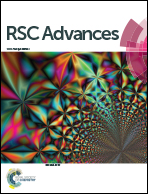Controlled growth of single-crystalline nanostructured dendrites of α-Fe2O3 blended with MWCNT: a systematic investigation of highly selective determination of l-dopa†
Abstract
α-Fe2O3 dendritic nanostructures were prepared by simple hydrothermal method and then blended with MWCNT (multiwall carbon nanotubes) to construct a novel biosensor for the determination of L-dopa. The structure of the new material was characterized by transmission electron microscopy (TEM), scanning electron microscopy (SEM) and X-ray diffraction (XRD) and the electrochemical behavior of L-dopa was also studied by cyclic voltammetry (CV), differential pulse voltammetry (DPV) and amperometry in phosphate buffer solution (PBS) at pH 7.2. The experimental results suggested that α-Fe2O3 blended MWCNT composite showed 3-fold increase of the oxidation peak current compared to that of the bare electrode. The DPV current responses of L-dopa were increased linearly in the range from 5.0 × 10−8 to 3.8 × 10−6 M with a lower detection limit of 30 nM (3σ). Finally, the proposed sensor was demonstrated for the sensitive determination of L-dopa in pharmaceutical samples and the obtained results were quite promising.


 Please wait while we load your content...
Please wait while we load your content...